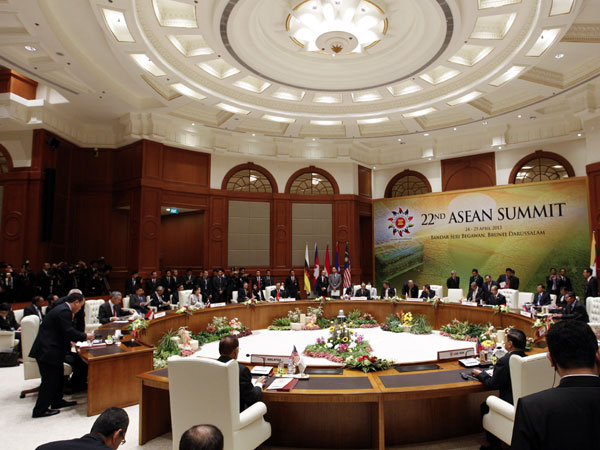China, 15 other Asian nations to start trade talks

Leaders of the Association of Southeast Asian Nations (ASEAN) attend Retreat meeting of the 22nd ASEAN Summit in Bandar Seri Begawan, Brunei, Thursday, April 25, 2013. AP
BANDAR SERI BEGAWAN, Brunei—China and 15 other Asia-Pacific nations will kick off the first round of free trade talks next month to create one of the world’s largest trading blocs, officials said Thursday.
The Regional Comprehensive Economic Partnership is a rival pact to the US-led Trans-Pacific Partnership, a free trade initiative involving a dozen countries but that excludes China. Both the pacts underline competition between the US and China for influence in Asia.
At the end of a two-day gathering in Brunei on Thursday, leaders of the 10-member Association of Southeast Asian Nations said in a statement that negotiations on the comprehensive partnership will commence next month in Brunei “with a view to completing them by 2015.”
Negotiators from the 16 countries will meet for five days from May 9 in Brunei to outline the scope of talks in the areas of goods, services and investment.
The comprehensive partnership covers Thailand, Brunei, Cambodia, Indonesia, Laos, Malaysia, Myanmar, the Philippines, Singapore and Vietnam plus that grouping’s six key trading partners — China, Japan, South Korea, Australia, New Zealand and India. The Southeast Asian grouping of countries already has separate free trade pacts with the six nations.
Article continues after this advertisementOfficials said the comprehensive free-trade pact, flagged by East Asian leaders at their summit in Cambodia just five months ago, was an expected outcome of efforts to merge various free trade agreements in the region to maximize the economic benefits.
Article continues after this advertisementWith the bustling region of 3.3 billion people accounting for about a third of the world economy, a successful accord could significantly bolster trade and investment.
Some analysts said the complexity of the various trade agreements that need to be welded together means the comprehensive agreement will sacrifice an aggressive lowering of trade barriers to ensure a consensus is reached by the 2015 deadline.
It will have a narrower scope than the Trans-Pacific pact and doesn’t cover issues such as intellectual property rights, reform of state-owned enterprises or regulatory standards, said Sanchita Basu Das, economic researcher at Singapore’s Institute of Southeast Asian Studies.
“It will not be a gold-standard agreement,” she said.
Under the comprehensive pact’s guidelines, special and differential treatment is allowed for poorer nations such as Cambodia, Laos, Myanmar and Vietnam. At the same time, flexibility clauses also allow members to drop trade policies with which they disagree and exclude sensitive industries from competition.
While such flexibility makes it more attractive for developing nations to join the grouping, critics said it could also be a roadblock to greater integration and a handicap for countries unwilling to reform.
Seven of the comprehensive partnership members — Brunei, Malaysia, Singapore, Vietnam, Australia, New Zealand and Japan — are also involved in Trans-Pacific talks. Chile, Canada, Mexico, Peru and the United States are the other members in the Trans-Pacific Partnership, which accounts for nearly 40 percent of global GDP and about a third of world trade.
Negotiations on the Trans-Pacific pact began in 2005 and President Barack Obama’s administration has said it hopes to wrap up talks by the end of this year. The pact is crucial to the US as it seeks to reassert itself as an Asian and Pacific power, countering China.
Washington has only a handful of trade agreements in Asia, unlike China which has inked pacts with many countries and recently restarted three-way free trade talks with South Korea and Japan.
“America doesn’t want China in the TPP but rather than saying it outright, they crafted the agreement so deeply that they know the Chinese can’t do it,” said Simon Tay, who heads Singapore’s Institute of International Affairs. “At the moment, the regional comprehensive partnership is shallow, but healthy competition from the TPP can galvanize members to go a bit further to make it more meaningful.”